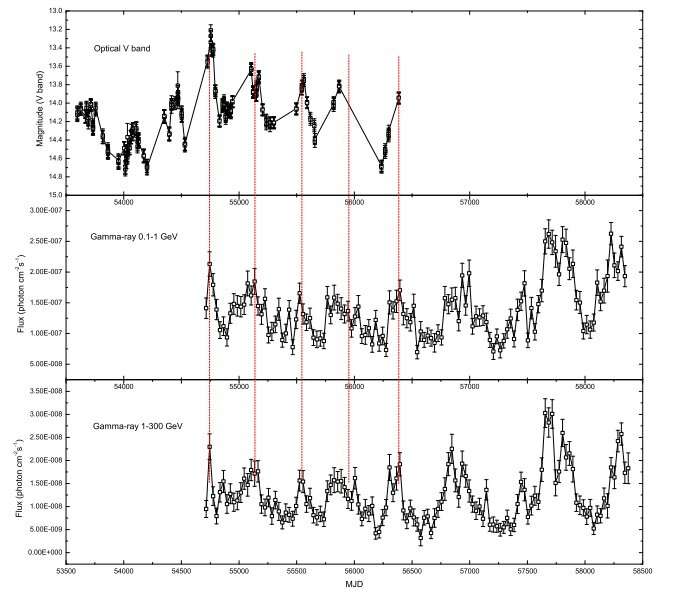April 1, 2020 report
Astronomers perform variability study of the blazar 3FGL J0449.4-4350

Chinese astronomers have conducted a gamma-ray and optical variability analysis of the blazar 3FGL J0449.4-4350. The new research, presented in a paper published March 25 on arXiv.org, reports the detection of possible quasi-periodic oscillation (QPO) from the source and provides more insights into the origin of such behavior.
Blazars are very compact quasars associated with supermassive black holes at the centers of active, giant elliptical galaxies, and can exhibit variability on a wide range of timescales. They belong to a larger group of active galaxies that host active galactic nuclei (AGN), and their characteristic features are relativistic jets pointed almost exactly toward the Earth.
Based on their optical emission properties, astronomers divide blazars into two classes: flat-spectrum radio quasars (FSRQs) that feature prominent and broad optical emission lines, and BL Lacertae objects (BL Lacs), which do not.
At a redshift of 0.205, 3FGL J0449.4-4350 (also known as PKS 0447-439) is a BL Lac known to showcase variability in optical band and gamma-rays. In particular, observations show that its optical band and gamma-ray flux synchronously change, therefore, long-term monitoring is essential for understanding the typical behavior of this source.
Recently, a group of astronomers led by Xing Yang of Yunnan Normal University, China, has performed a time series analysis of the light curves of 3FGL J0449.4-4350. Yang's team has combed through the archival data from the Catalina Real-time Transient Survey (CRTS) and NASA's Fermi spacecraft, aiming to shed more light on the variability of this object.
"We have assembled the historical light curves of the BL Lac Object 3FGL J0449.4-4350 at optical and γ-ray bands, the time spanning about 10 years, analyzed the periodic variability of the light curves by using four different methods (Lomb-Scargle periodogram, REDFIT38, Jurkevich and DACF)," the researchers wrote in the paper.
Searching for quasi-periodicity in the light curve of 3FGL J0449.4-4350, the astronomers found a possible QPO of about 450 days. The researchers emphasize that further studies are required in order to confirm this finding, as it is difficult to distinguish periodic and stochastic signals in the light curve of blazar.
However, if the signal is really a QPO, the authors of the paper suppose that the possible physical reason of such quasi-periodicity could be a helical motion of the blazar's jet in a supermassive binary black hole (SMBBH) system. If this scenario is true, the mass of the primary black hole should be about 7.7 billion solar masses.
"The helical motion of the jet is most likely driven by the orbital motion in the SMBBH system, which imply that 3FGL J0449.4-4350 is a possible candidate of SMBBH. According to cold dark matter (CDM) cosmology model, SMBBH is formed after the merger of galaxies," the paper reads.
The astronomers added that the physical driving quasi-periodicity of helical motion of the jet in 3FGL J0449.4-4350 was estimated to be at least about 56 years, but some calculations point to even 230 years.
More information: The gamma-ray and Optical Variability Analysis of the BL Lac Object 3FGL J0449.4-4350, arXiv:2003.11280 [astro-ph.HE] arxiv.org/abs/2003.11280
© 2020 Science X Network



















